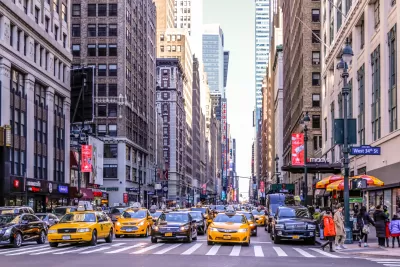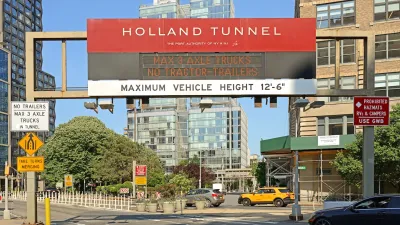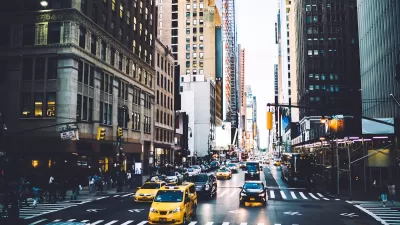Starting this summer, drivers will have to pay a toll to drive through the newly designated Congestion Relief Zone in New York City’s Central Business District.

ABC 7 Eyewitness News reports that, five years after passing in the state legislature, New York City’s controversial congestion pricing plan will go into effect on June 30. During peak hours (5 a.m.–9 p.m. on weekdays, 9 a.m.–9 p.m. on weekends), the toll structure for vehicle travel through the Congestion Relief Zone will be as follows:
- Cars: $15 toll during peak hours, and $3.75 overnight
- Trucks and buses: $24 or $36 (depending on size and purpose) and $6 and $8 overnight
- Motorcycles: $7.50 a maximum of once a day.
- Passengers of taxis, green cabs, and for-hire vehicles: $1.25 per trip
- Passengers of high-volume for-hire services like Lyft and Uber: $2.50 per trip
MTA officials say these tolls will result in 100,000 fewer vehicles entering the area every day, leading to less traffic, cleaner air, and revenue that will go toward public transit investments. ABC 7 also reports the MTA launched a portal for people to learn about eligibility for discounts or exemptions, which they can already start applying for.
The program will be the first its kind in the United States, though congestion pricing is quite popular in Europe. Opponents say the fees will burden workers, result in higher prices of goods transported into the city by truck, and simply shift congestion outside of the zone. There are also multiple pending lawsuits from small business owners and the state of New Jersey that have yet to be. Proponents say if done right, the plan could pave the way for similar congestion pricing plans across the country.
FULL STORY: MTA announces official start date for congestion pricing in New York City

Planetizen Federal Action Tracker
A weekly monitor of how Trump’s orders and actions are impacting planners and planning in America.

Congressman Proposes Bill to Rename DC Metro “Trump Train”
The Make Autorail Great Again Act would withhold federal funding to the system until the Washington Metropolitan Area Transit Authority (WMATA), rebrands as the Washington Metropolitan Authority for Greater Access (WMAGA).

The Simple Legislative Tool Transforming Vacant Downtowns
In California, Michigan and Georgia, an easy win is bringing dollars — and delight — back to city centers.

The States Losing Rural Delivery Rooms at an Alarming Pace
In some states, as few as 9% of rural hospitals still deliver babies. As a result, rising pre-term births, no adequate pre-term care and harrowing close calls are a growing reality.

The Small South Asian Republic Going all in on EVs
Thanks to one simple policy change less than five years ago, 65% of new cars in this Himalayan country are now electric.

DC Backpedals on Bike Lane Protection, Swaps Barriers for Paint
Citing aesthetic concerns, the city is removing the concrete barriers and flexposts that once separated Arizona Avenue cyclists from motor vehicles.
Urban Design for Planners 1: Software Tools
This six-course series explores essential urban design concepts using open source software and equips planners with the tools they need to participate fully in the urban design process.
Planning for Universal Design
Learn the tools for implementing Universal Design in planning regulations.
Smith Gee Studio
City of Charlotte
City of Camden Redevelopment Agency
City of Astoria
Transportation Research & Education Center (TREC) at Portland State University
US High Speed Rail Association
City of Camden Redevelopment Agency
Municipality of Princeton (NJ)





























